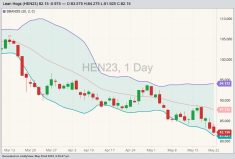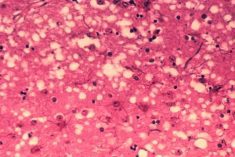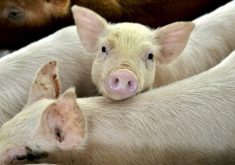Canadian beef cattle producers handed over more samples in 2016 than in 2015 to be tested for BSE, turning up zero cases of the brain-wasting disease.
The Canadian Cattlemen’s Association on Monday reported 27,346 samples were submitted to the national BSE surveillance program in 2016 — up four per cent from 26,285 in 2015, but down from 27,531 in 2014 and well down from the annual target of 30,000 set in 2003.
Despite the shortfall, the CCA said it “remains confident” Canada’s level of bovine spongiform encephalopathy (BSE) surveillance and controls will allow the country to keep its “controlled risk” status “and when appropriate, seek a change in risk status from the World Organization for Animal Health (OIE).”
Read Also

Trump tariff on Brazilian goods could jack up U.S. burger price
U.S. President Donald Trump’s plan for a 50 per cent tariff on goods from Brazil will likely raise prices for the beef that is used in American hamburgers, traders and analysts said on Thursday, as food manufacturers increasingly rely on imports during a time of declining domestic production.
The improved sample submission rate was a “welcome result” given Canada’s shrinking beef cattle herd and “other challenges” in meeting the target, the CCA said.
“Maintaining a credible level of BSE surveillance to demonstrate that Canada’s control measures are effective and are working towards eradicating the disease is important,” CCA general manager Rob McNabb said in a release Monday.
Canada’s surveillance program in 2015 detected the country’s most recent case of BSE, a 70-month-old purebred black Angus beef cow in Alberta.
The cow, born in March 2009, was euthanized in February that year after its owner reported it as a “downer” cow, fitting the criteria for testing under the surveillance program.
Dubbed Case 19, the cow also was Canada’s first case to be born after the country’s “enhanced” feed ban took effect in 2007, as well as Canada’s first to be born on the same farm as a previous Canadian BSE case — Case 17, found in 2010.
Case 19, however, posed a setback in Canada’s efforts to level up from “controlled risk” to “negligible risk” for BSE. By OIE standards, a country’s youngest case of BSE must have been born 11 years before “negligible risk” status can be considered.
Before Case 19, Canada had been on track to start the process in August 2015, but is now unable to seek “negligible risk” status until 2020 at the earliest.
CCA’s foreign trade committee in 2015 passed a resolution that the association work with the federal government to seek a revision to the OIE’s BSE code criteria for negligible risk, reducing the 11-year period.
That said, the CCA added Monday, the Case 19 investigation “confirmed to the world” that Canada has “robust controls and surveillance programs in place to prevent the spread of the disease and detect the small and declining number of cases that are expected to occur from time to time.”
The CCA on Monday urged producers to continue to submit at least one cow per year for BSE sampling.
Cattle between 30 months and 10 years of age provide the most valuable information in terms of monitoring the cattle population for BSE, the CCA said, but any animal older than 30 months of age that fits into one of the categories of “dead, down, dying or diseased” is a potential candidate for testing. — AGCanada.com Network




















